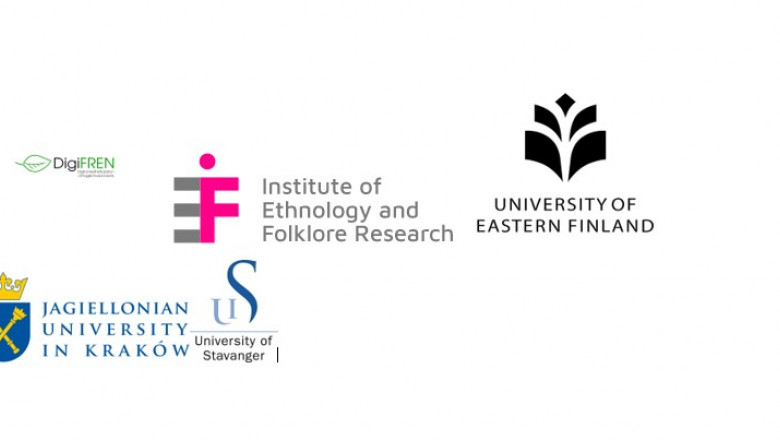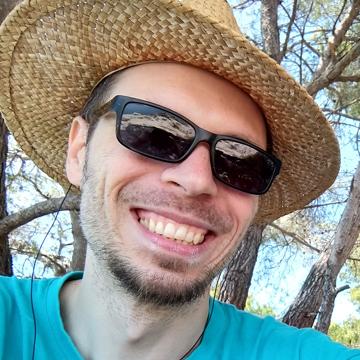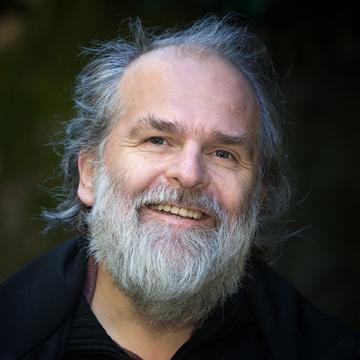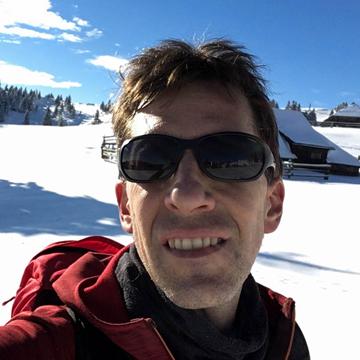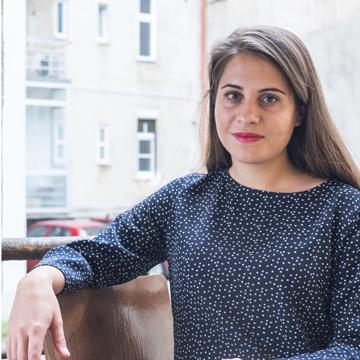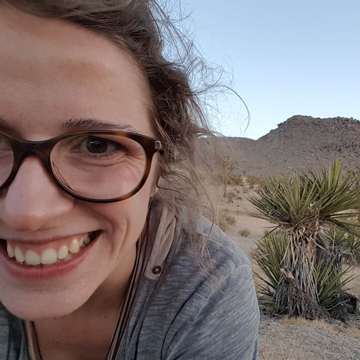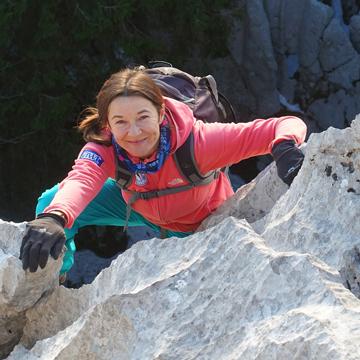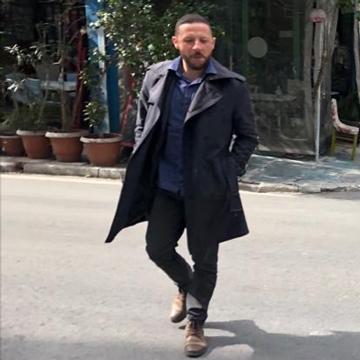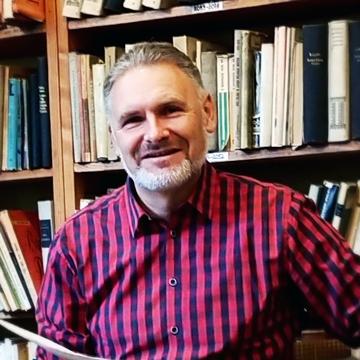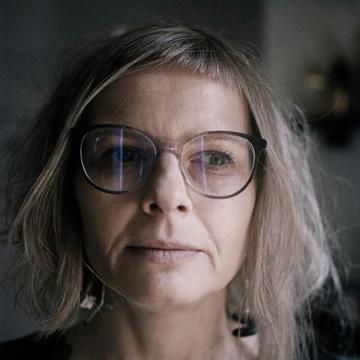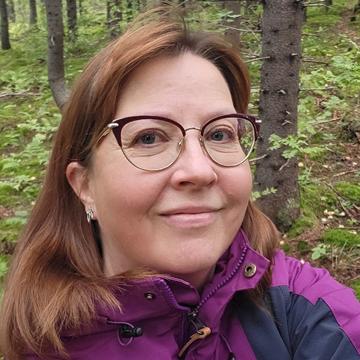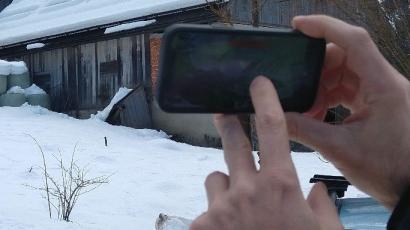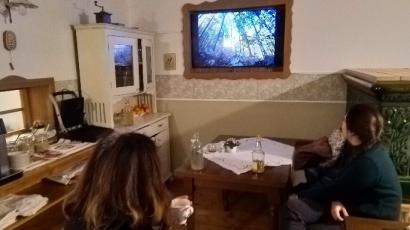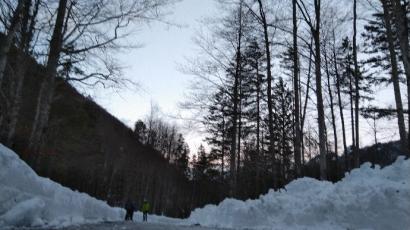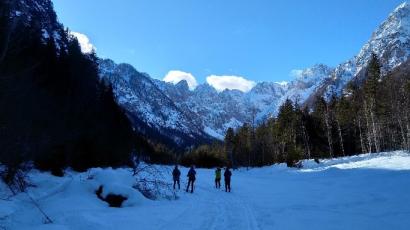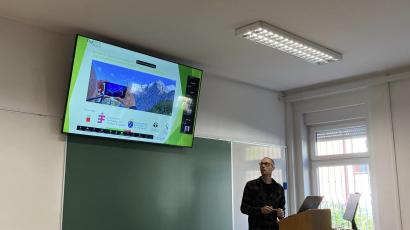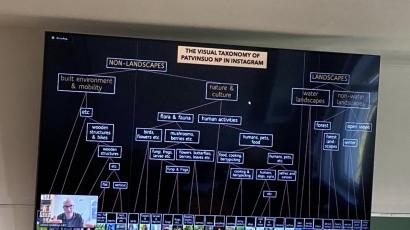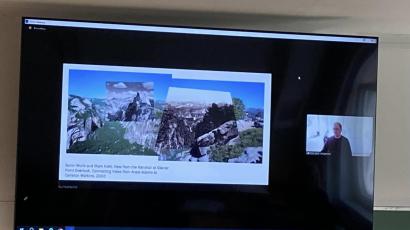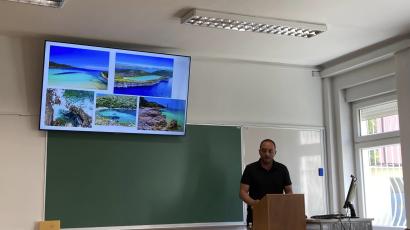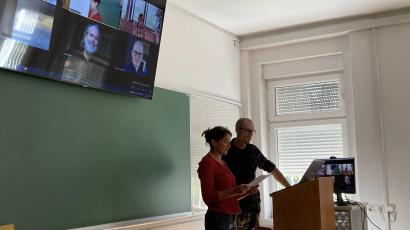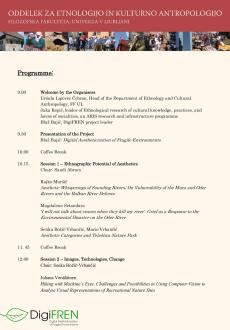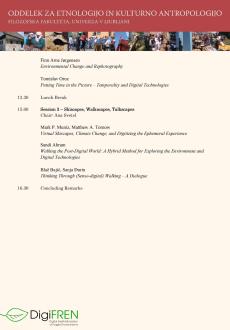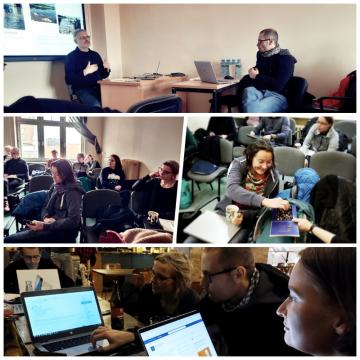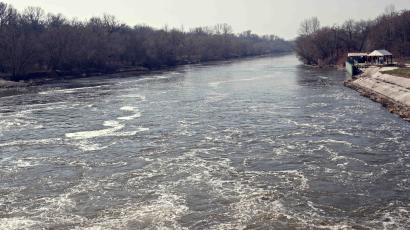

DigiFREN - Digital Aestheticization of Fragile Environments / Digitalna estetizacija ranljivih okolij
Ko se danes v gorah, ob morju in v gozdovih ozremo naokoli težko najdemo ljudi, ki ne bi tapkali po svojih pametnih telefonih, upravljali brezpilotnih letalnikov, uporabljali nosljivih kamer ali drugih pripomočkov za digitalni »zajem« in »nadgradnjo« izkušenj. Razmerja, ki jih ljudje vzpostavljamo s svojimi okolji, so v večji meri posredovana z digitalnimi tehnologijami in mediji. Cilj projekta DigiFREN - Digitalna estetizacija ranljivih okolij je preučiti ta transformativni moment v evropskem kontekstu.
Čeprav se v času »pregrevanja« (Eriksen 2016) zdi še posebej pomembna, digitalna estetizacija (znotraj) krhkih okolij ostaja etnografsko relativno neraziskana. V humanistiki so o njej razpravljali predvsem v kontekstu teorije umetnosti, (novih) medijev in filozofiji. Izhajajoč in nadgrajujoč te razpravo bo DigiFREN digitalno estetizacijo naslovil kot se »spontano« odvija v vsakdanjem življenju.
Zgodovinsko in etnografsko utemeljena raziskava se osredija na digitalno estetizacijo (znotraj) krhkih okolij, se pravi na to, kako digitalni mediji in tehnologija preoblikujejo percepcijo, senzibilnosti, pojmovanja in prakse. Raziskava poteka v Sloveniji, na Hrvaškem, Finskem, Norveškem in Poljskem ter tako upošteva kulturno in ekološko raznolikost Evrope.
DigiFREN je pionirski projekt, ki se etnografsko in primerjalno loteva estetizacije okolja (in okoljskih sprememb) v digitalizirani Evropi. Razširja uveljavljene metodološke strategije, kot je opazovanje z udeležbo, ter uvaja eksperimentalno metodo senzo-digitalne hoje. DigiFREN je zasnovan za preučevanje spreminjajočih se in vse pomembnejših odnosov med spreminjajočimi se kategorijami človeka, tehnologije in okolja. Raziskava bo to bo prispevala uvide, relevantne ne le za antropologijo, zgodovino, kulturne in senzorične študije, ampak tudi za kulturno geografijo, okoljsko estetiko in medijske študije, njene ugotovitve pa bodo prispevale k učinkovitejšemu upravljanju in zaščiti krhkih okolij.
SLOVENIA
PL Blaž Bajič is a researcher at the Department of Ethnology and Cultural Anthropology, Faculty of Arts, University of Ljubljana, where, in 2017, he received his PhD. As a postdoctoral researcher in cultural studies at the School of Humanities of the University of Eastern Finland (2017-2021) he participated in the SENSOTRA project (ERC-2015-AdG 694893). His areas of interest include anthropology of the senses, popular culture and leisure, everyday life, anthropology of space and place, urban anthropology, globalization, anthropology of art and creativity, digitization, ecology, epistemology, etc. He also participated in the TRACES (H2020-EU.3.6.-693857; 2016-2019) and CSI CustomDigiTeach (KA226-050D8E8E; 2021-2023).
Recently, he co-edited the Senses of Cities: Anthropology, Art, Sensory Transformations (with Rajko Muršič and Sandi Abram; University of Ljubljana Press, 2022), Views of the Three Valleys (with Ana Svetel and Veronika Zavratnik; University of Ljubljana Press, 2021), Close-ups: Youth, the Future and Imagining Development in Solčavsko (with Ana Svetel and Veronika Zavratnik; University of Ljubljana Press, 2022) and Sensory Environmental Relations: Between Memories of the Past and Imaginings of the Future (with Ana Svetel; Vernon Press, 2023).
In 2021, Bajič was awarded the Emerging Scholar Award for outstanding early-career researchers by OnSustainability Research Network. He is also the current president of the Slovenian Ethnological and Anthropological Association KULA.
Sandi Abram holds a PhD from the University of Eastern Finland. Between 2017-2021 he participated as doctoral researcher in the ERC-funded project SENSOTRA - Sensory Transformations and Transgenerational Environmental Relationships in Europe 1950-2020 (ERC-2015-AdG 694893). Between 2012-2020, he was a member of the editorial board of the Journal for the Critique of Science and Imagination, and New Anthropology, and is currently a member of the Scientific Committee of the Street Art and Urban Creativity Journal. In 2021, he co-edited (with Blaž Bajič and Rajko Muršič) the book Senses of Cities: Anthropology, Art, Sensory Transformations (Ljubljana University Press). Since 2022, he also participates as a postdoctoral researcher in DigiFREN- Digital Aestheticization in/of Fragile Environments and ECSEuro - Enacting Citizenship and Solidarity in Europe “From Below”: Local Initiatives, Intersectional Strategies and Transnational Networks. His research interests are in the fields of aestheticization, sensory and urban studies, non-institutional creative practices, multimodal and collaborative ethnography. In 2020 he was awarded the Finnish Cultural Foundation scholarship.
Rajko Muršič is professor of ethnology/cultural anthropology at the University of Ljubljana, Faculty of Arts, Dept. of Ethnology and Cultural Anthropology. His research focuses on anthropology of popular music, theories of culture, epistemology, urban anthropology, methodology of anthropological research, sensory studies, digital ethnography, the use of algorithms, etc. His regional interests comprise Slovenia, Central and South-Eastern Europe (fieldwork in Slovenia, Poland, North Macedonia, Germany, and Japan).
He published eight monographs (all in Slovene) and co-edited eleven collections (six in English). He served as a member of the Executive Committee of the IUAES and a president of the Slovenian Ethnological and Anthropological Association Kula. He was initial editor of the monograph series Zupanič’s Collection.
As the principal researcher he completed two national research projects. Recently, he was engaged as an expert researcher in the ERC project Sensotra (Sensory Transformations and Transgenerational Environmental Relationships in Europe, 1950-2020) at the University of Eastern Finland (2016-2021), and he is active in the project B-Air (Art Infinity Radio - Creating Sound Art for Babies, Toddlers and Vulnerable Groups) led by Radio Slovenia (2020-2023). He is as well the leader of the partner’s team in the Erasmus+ project Happy (Qualitative Research in Higher Education Teaching Approaches for Sustainability and Well-being in Bhutan), led by the Free University in Amsterdam. Since 2022, he participates in two projects, financed by the programme Chanse: Reimagining Public Values in Algorithmic Futures and Digital Aestheticization in/of Fragile Environments.
His recent works include Glasbeni pojmovnik za mlade (Music Glossary for the Youth), 2017; Sounds of Attraction: Yugoslav and Post-Yugoslav Popular Music (co-editor Miha Kozorog), 2017; Občutki mest: antropologija, umetnost, čutne transformacije (Senses of Cities: Anthropology, Art, Sensory Transformations; co-editors Sandi Abram and Blaž Bajič), 2022.
Jaka Repič is an associate professor of cultural and social anthropology at the Department of Ethnology and Cultural Anthropology, Faculty of Arts, University of Ljubljana. He completed his PhD thesis in 2006 with a study of transnational migrations between Argentina and Europe, with a special focus on the Slovenian diaspora in Argentina and return mobilities. He teaches courses on the methodology of ethnology and cultural anthropology, current debates in social and cultural anthropology, urban anthropology, and ethnology of Australia and Oceania.
He was a visiting professor at Universidad Autónoma de Barcelona (2019-20) and Universidad de Buenos Aires (2010-11, 2015, 2017, 2023). He is currently the leader of a research programme Ethnological research of cultural knowledge, practices and forms of socialities (2022-2027).
Jaka Repič’s research interests include diaspora studies, social memories, urbanisation and spatial studies, and anthropology of art. He has published two books in Slovenian (“Tracing roots”: Transnational Migration between Argentina and Europe and Urbanization and Constitution of Ethnic Communities in Port Moresby, Papua New Guinea). His recent publications include an edited volume Moving Places: Relations, Return and Belonging (co-edited with Nataša Gregorič Bon, Berghahn books, 2016) and a special issue on Art and Migration in the journal Two Homelands. In the past years he has also focused on the environmental changes and spatial practices in the Slovenian Alps.
Ana Svetel works as a researcher at the Department of Ethnology and Cultural Anthropology at the Faculty of Arts and at Institute for Innovation and Development of University of Ljubljana. Her research interests include anthropological studies on landscape, environment, perception, remoteness, seasonality, weather, luminosity and naming. She conducted ethnographic fieldwork in northeastern Iceland and Slovenian Alps. She is a co-chair of Young Scholars Working Group in the International Society for Ethnology and Folklore (SIEF) and a member of the editorial boards of the Bulletin of the Slovene Ethnological Society Library series and journal Svetovi / Worlds. In 2022, Svetel was awarded the Emerging Scholar Award for outstanding early-career researchers by OnSustainability Research Network.
Veronika Zavratnik is a teaching assistant and researcher at the Department of Ethnology and Cultural Anthropology, Faculty of Arts, University of Ljubljana, where in 2023 she completed her PhD on footwear in everyday life. Since 2021, she also works as a researcher at the Institute for Innovation and Development of University of Ljubljana (IRI UL). Her broader research interests include material culture, digitalization, environment, sustainability, applied anthropology. She is currently involved in several projects related to digitalization, energy, and innovative teaching approaches. Recently, she co-edited Handicrafts in Slovenia: Contemporary Challenges and Perspectives (with Mateja Habinc; University of Ljubljana Press, 2022), Views of the Three Valleys (with Blaž Bajič and Ana Svetel; University of Ljubljana Press, 2021), and Close-ups: Youth, the Future and Imagining Development in Solčavsko (with Ana Svetel and Blaž Bajič; University of Ljubljana Press, 2022). She is the managing editor of Svetovi/ Worlds: Journal for Ethnology, Anthropology and Folkloristics, published by University of Ljubljana Press. In 2020, she was awarded the Emerging Scholar Award for outstanding young scholars in the field of sustainability by the OnSustainability Research Network.
CROATIA
PI Sanja Đurin is a senior research assistant at Institute of ethnology and folklore research in Zagreb, Croatia. She obtained a B.A. in Philosophy and General Linguistics from Faculty of Humanities and Social Sciences, University of Zagreb, and M.A. in Social Anthropology (case study: prison Lepoglava) from Institutum Studiorum Humanitatis (ISH), Slovenia. Winner of HESP stipend for PhD study. Her doctoral thesis (obtained at Institutum Studiorum Humanitatis (ISH), Slovenia) is analyzing the politics of sexuality in Croatia across different political regimes (1941-2000).
Through the lens of social anthropology and cultural studies, so far she was researching different social niches characterized by uneven power distribution and its consequences – subjugation and marginalization, i.e. discursive production of marginality. Her target were social, gender and other minority items as well as subjugated identities (prisoners, waitresses, gay people) and public policies. She collaborated on several domestic and international projects and has extensive experience in field work in Germany, Chile and Argentina, which encourages her to constantly question established research methods in anthropology. In recent years, her research work is focused on adventure and outdoor activities in everyday life, through the prism of climate change and environmental disasters and in the context of fourth (digital) industrial revolution.
Senka Božić-Vrbančić is a Professor in Anthropology at the University of Zadar, Croatia. She holds a PhD in Anthropology from the University of Auckland, New Zealand. She has worked at the University of Melbourne, Australia (McArthur Research Fellowship 2007-2010), Center for Sociology and Cultural Studies in Lviv, Ukraine and Institute for Anthropological Research, Zagreb, Croatia. Her work spans the fields of anthropology, cultural and visual studies with an emphasis on affective components of belonging. Her work has been published in various journals and edited collections including Oral Histories and Public Memories (Temple University Press 2008) and Waiting (Melbourne University Press, 2008). She is the author of two books Tarara: Croatians and Maori in New Zealand - memory, belonging, identity (Otago University Press 2008, 2018) and Hitchcockian gaze: a paranoid reading of contemporary culture (Jesenski & Turk, 2017). She is currently finishing a book on the precariousness as a social condition based on an ethnographic research of everyday work on digital platforms in Croatia and the structures of feeling associated with them.
Mario Katić is Associate Professor at the University of Zadar, Department of Ethnology and Anthropology. His main areas of interest are pilgrimage, folklore and death studies; urban anthropology; and research methodology. He is co-editor of Pilgrimage, politics and place-making in Eastern Europe (Routledge, 2014), Pilgrimage and sacred places in southeast Europe (Lit Verlag, 2014), Military pilgrimage and battlefield tourism (Routledge, 2017). Since 2020 he has been the PI of the research project Adriatic Maritime Pilgrimages in Local, National and Transnational Context (Croatian Science Foundation).
Tomislav Oroz is associate professor at the Department of Ethnology and Anthropology, University of Zadar. He holds a MA degree in ethnology and cultural anthropology and history from the University of Zagreb. At the same University he obtained a Ph.D. in ethnology and cultural anthropology. His teaching activities at his home university include several courses both on the undergraduate and graduate level (Anthropology of the Mediterranean, Ethnocultural processes in Southeastern Europe, Cultures of Memory and Experience of Temporality, etc.).
His research interests explore the intersection of memory studies, island studies and Balkan studies with special emphasis on the problems of island temporalities, problems of belated modernity and aestheticization of island environments. His publications include the monograph Gdje si bio 1573? Lica i naličja Matije Gupca u praksma sjećanja [Where were you in 1573? Diverse Faces of Matija Gubec in Memory Practices] (2018) for which he won Milovan Gavazzi yearly award of Croatian Ethnological Society. With Miranda Levanat-Peričić he co-edited the volume Liber monstrorum balcanorum: čudovišni svijet europske margine [Liber monstrorum balcanorum: monstruous world of European periphery]. Currently he serves as the head of Department of Ethnology and Anthropology at his home university (2022-2026). He is engaged as co-opted member of executive board of ISISA (International Small Island Studies Association). He is PI of university research project A Network of Island Temporalities– Multidisciplinary Research of Experiences of Temporalities on the Islands of Dugi otok and Kornati.
POLAND
PI Marcin Brocki is an associate professor at Jagiellonian University in Krakow (Poland). His research interests revolve around the theory and methodology of anthropological research, semiotics, community studies, social and economic transformation, and anthropology of the body, but he also focused in his writings on such topics as the social construction of landscape or participatory research. He conducted his fieldwork in diverse sites in southern Poland (on transition and society and rapid industrial development and its impact on the local community) and did anthropological surveys in Zimbabwe (on “informal social protection systems” within the framework of the UNDP program).
Magdalena Sztandara is an anthropologist working at the Institute of Ethnology and Cultural Anthropology at the Jagiellonian University in Krakow. Her research interests include issues of performative ethnography, visual anthropology, feminist ethnography, methodology of ethnographic research, and teaching anthropology. In recent years, her research has focused on the themes of disobedience and disloyalty in (post-)Yugoslav space, restorative justice and ageing and activism. For several years, she has been leading international educational projects based on a research-based teaching technique that combines the teaching of anthropology with the theory and methodology of ethnographic research. As part of her authorial ethnographic-performative laboratories, she conducted projects on intimacy and familiarity in urban spaces, gentrification, activism, and ageing.
FINLAND
PI Juhana Venäläinen works as an Associate Professor of Cultural Studies at the University of Eastern Finland, Joensuu. His research topics range from transformations of work and everyday economic thought to multisensory ethnography and environmental relationships. An important thread between these topics – and already taking shape in his PhD thesis (2015) – has been the ambition to explore the diverse roles and contexts of the “commons” in creating economic value within contemporary capitalism. Venäläinen has published research articles and edited books and journals’ special issues about precarious work, affect theory, economic cultures, and the epistemologies of cultural studies. His research on the commons has been awarded by the Kone Foundation “Academic Pen of the Year” for the best Finnish research article in social sciences (together with Tero Toivanen). Recently, Venäläinen contributed to the ERC AdG project “SENSOTRA” in developing the notion of the sensory commons and devising the ethnographic method of sensobiographic walks. In DigiFREN, he leads Work Package 2 on “Navigating Aestheticization”.
Kirsi Laurén, Adjunct Professor, works as a Senior Researcher of Cultural Studies in the School of Humanities, University of Eastern Finland (UEF). She represents disciplines of folklore studies and cultural anthropology. Her research interests include e.g., cultural environmental research, research on cultural change, narrative analysis, anthropology of senses, oral history research, traditions and cultural heritage, and humanistic border studies. She leads the Mire Trend research project (2020–2023 funded by the Finnish Kone Foundation) in UEF. In DigiFREN she studies the implementation of digital aestheticization in the context of protected mires and peatlands in Eastern and Northern Finland.
Tiina Seppä is an Adjunct Professor of Folklore Studies at the University of Eastern Finland, senior researcher at School of Humanities, UEF Finland. Her research interests include the folklore collection and construction project, colonial processes, and immaterial conditions (such as affections and economy) in folklore collecting process and, recent years, interspecies relations in folklore and human-environment relationships. She is president of the Finnish Folklore Society and has just received funding for the project "Wandering in the woods. Forest-human relations in archived oral folklore" from the Kone Foundation. Seppä has also written his research in the form of art: more specifically, radio plays for the Finnish Broadcasting Company. She is interested in the experimental artistic methods in research. She also enjoys nature, forests and bogs, and records these experiences on her mobile phone, as well as the catches from her mushroom foraging trips.
Sanni-Maaria Puustinen works as a research assistant at School of Humanities in University of Eastern Finland. She is currently finishing her Master's Thesis in folklore studies, and her interests goes towards human-animal studies and human-environmental relationships. These themes are also embedded in her work as a Fine Artist. Her work in the field of Art includes multisensorial and community-engaged art, as well as exhibitions and public artworks. She lives in the rural area on a small farm, raising sheep and foraging in the surrounding forests and lakes.
NORWAY
PI Finn Arne Jørgensen is a professor of environmental history at the Department of Cultural and Linguistics. In his research, he focuses on encounters between technology, nature, and culture. In the last couple of years, he has also worked extensively with digital media and digital cultural heritage. In his previous position as an associate professor in technology and environmental history at Umeå University (2010-2017), he was appointed as a meritorious teacher in 2016. In 2021, he was also appointed as a meritorious teacher at the University of Stavanger. He is happy to guide master's students within his areas of competence and interest - contact him for an overview of possible topics and proposals for assignments.
Much of his research takes place within the framework of externally funded research projects: In the period 2019-2023, he is particularly busy with the project "Locative Technologies and the Human Sense of Place" which he received from the Research Council of Norway's FRIPRO programme. Here he collaborates with Karen Lykke Syse at the Center for Environment and Development, UiO. In addition, he leads the EU project EnviroCitizen, where seven European partners investigate how citizen science within ornithology, such as bird counting and ringing, can contribute to increased environmental commitment and green citizenship. The project runs from 2020-2023. At the turn of the year 2022/2023, the DigiFREN (Digital Aestheticization of Fragile Environments) project will start, a large European collaborative project on digital technologies and changing landscapes, funded by CHANSE. At UiS, historical re-photography will be used as an input into a historical study of Sørmarka.
Finn Arne Jørgensen's latest books are Silver Linings: Clouds in Art and Science (Museumsforlaget 2020), edited together with Dolly Jørgensen, and Recycling (MIT Press, 2019).
Senso-digital walking methodological companion
Across diverse European environments, one can readily observe that how people engage with their surroundings have changed dramatically. In the mountains and the forests, along riverbanks and seacoasts, it is hard to find anyone who is not tapping on their smartphones, flying drones, or using wearable cameras, or other digital gadgets to “capture” and augment their experiences. The objective of Digital Aestheticization of Fragile Environments – DigiFREN is to study this transformative chapter in the history of environmental relations in Europe. (DigiFREN 2022)
Taking augmented photos in Lograska dolina. (photo: Blaž Bajič)
Marvelling at the photos taken by our interlocotur during one of her previous outings. (photo: Blaž Bajič)
The question, then, is a simple one: how? How are we to engage with the ubiquitous, yet almost impalpable process that we have termed digital aestheticization? To answer this question somewhat satisfactorily we would have to go into some detail about what precisely we mean by “digital aestheticization”, as well as its socio-historic, cultural, and technological conditions. We will do this in one of the upcoming entries. Presently, however, the aim is – based on the preliminary walks conducted during a recent visit to Solčavsko – simply to take the first step in outlining an emergent method (or, at the very least, a new twist on an established method), namely senso-digital walking.
A quick sketch of how we envisioned the sensory-digital walking method (SDW) is in order. With SDW we imagined a “hybrid” (sensu Przybylski 2021) experimental method, inspired by mobile methods in the ethnographic study of sensory experience and technology (cf. Bajič and Abram 2019; Jørgensen 2017; Venäläinen, Pöllänen, and Muršič 2020). SDW’s express aim is to engender reflection at the “interface between the physical and the digital” (Dufva and Dufva 2019: 23).
In recent years, walking attained a (proto-)methodological status as it affords dynamic, multisensory encounters with the environment, and it was noted that walking together with others can help us “'creatively construct correspondences' [Okely 1994] between our own and others' experiences” (Pink 2015: 47). While there are other methods that utilize walking, we opt for the development of senso-digital walking, because, drawing on recent considerations of the “post-digital world” (Berry 2014), we estimate that none provide for a sufficient focus on the overlap of sensory perception, on the one hand, and the uses of digital media and technologies, on the other. With SDW, we enable temporally and spatially focused ethnographic study of the interrelatedness and in-betweenness of the digital and the non-digital, online, and offline engagements (Przybylski 2021; Zavratnik and Svetel 2021; Podjed and Muršič 2021). While other forms of mobility are far from irrelevant when it comes to digital aestheticization, we – initially, at least – settled for walking for reasons of its historical connections to aesthetic perception, contemporary commonplaceness (popularity as an outdoor leisure practice, in fact), research practicality, and several researchers’ experience with walking methods in their past work. In any case, walking should be understood as a generic term encompassing diverse modes of movement (and sensory and possibly digitally mediated engagement) within an environment, from cross-country skiing and climbing to kayaking and cycling.
The plan is to ask the research participants - whilst walking through an environment together with a researcher, and in contextually suitable ways - to discuss their uses of digital technologies before, during, and after their activities in the “environment itself”, as well as the relationships between (their experiences of) “real” and “digitally aestheticized” environments. Both the perceived similarities and differences are to be addressed, as are the memories of, and anticipations regarding the environments, and the impressions and feelings these may have contributed to. Moreover, we have imagined that SDW can, when and where appropriate, incorporate techniques such as photo-elicitation and rephotography, i.e., using historical, contemporary, and/or combined images as an inspiration for reflection. Importantly, throughout the walks, the participants will be encouraged to use any gadget as they normally would and to describe how they may affect their sense of place, belonging, and identity. (Of course, much like with “digital aestheticization” a lot more could be and will be said about senso-digital walking’s “meaning” and its background (mobilities turn, the proliferation of go-along methods, etc. in the humanities and social sciences)).
Now, even if relatively simple as far as the practicalities go, developing anything approximating a new method is a lengthy and complex journey (and much more than just ambitious words are needed!), that begins – surprise, surprise! – with a single first step. The first step (both figurative and literal first step, in our case) was precisely what we were aiming for when members of the Ljubljana- and Zagreb-based research teams recently visited Solčavsko region in the Kamnik-Savinja Alps in Northern Slovenia. The SDW protocol is at this point in the research process a matter of debate, even if it is already evident that some leeway for adjustment to each context and improvisation on the go must become its built-in feature.
Given that some of us have been conducting ethnographic fieldwork in the region for several years now, we were confident in our choices of the first two “official” research participants – and both experiences indeed proved to be instructive, each in its own right. Both walkers are locals, one from Robanov kot, the other from Logarska dolina, i. e. two of the major valleys of Solčavsko, both work in tourism, and both are avid photographers, even if somewhat less enthusiastic about sharing them, and in the process promoting their businesses, via social media (since they are doing well enough even without it), and both women were asked to choose a path that they find exciting, are feel are knowledgeable about (at least to some extent). Both walks took place during a stretch of rather cold weather, with copious amounts of snow and ice – these may appear as extra-methodological occurrences, accidental events with no bearing on methodological considerations. These (and some other) similarities notwithstanding, the two walks proved to be immensely different – both regarding the topics discussed (these, we leave to be reflected upon at another opportunity) and regarding the very “form” of the exercise. With one walker it only made sense that we walk along a ploughed if somewhat icy road, and not along her favoured mountain path, since the interlocutor is recovering from an injury and the trail was all but inaccessible. With the other walker it was only possible to go by touring skis since there was simply too much snow and no ploughed roads in the valley we traversed.
Icy road in Logarska dolina at dusk. (photo: Blaž Bajič)
On the right: The ski cross party in Matkov kot. (photo: Blaž Bajič)
The mode of movement, naturally, set not only the tempo of movement but also how we “choreographed” the entire endeavour (so, as we can see, while the environmental and meteorological conditions can hardly be described as parts of the method as such they obviously connect to the form of each individual SDW, and can ostensibly serve a heuristic purpose as they are clearly important for the very subject of the study, as the conversations we had with our two walkers suggest). This proved to be crucial if we wanted to maintain a somewhat regular flow of conversation in the rather large group, too large of a group of researchers in fact (there were four of us!) and in each instant the single research participant. Of course, how this was done was a matter of conditions and affordances of the environment(s) and the technologies employed (see e.g., Ingold and Vergunst 2008), as well as bodily techniques. When walking, at least if the terrain one is moving through or if the width of the trail one is walking on allow it, it is not unusual for people to walk alongside one another. When ski touring, in contrast, moving abreast is more of an exception; skiers tend to move in line. (For this reason, especially, it was interesting to observe how the research participant moved laterally to ski alongside each of the researchers (one at a time), so we could talk and how at moments we would spontaneously stop simply to discuss this or that – again, something rather unusual in a ski touring context). Combined with the churching of the skis and the poles breaking the snow, skiing together accentuated the challenges “latent” in walking, that is, how to converse, how to attend together to the environment, how to reflect on the uses of digital technologies and media. Having said that, the difficulties mentioned should by no means be seen as reasons to discard modes of movement other than walking, such as ski touring, but also the aforementioned climbing, kayaking, cycling, and others – these are, especially in contexts of outdoor leisure, just as important socio-culturally and economically (if not more so), and if they bring with them challenges for an emergent go-along method it because they are testing the scope of the method. If anything, the predicaments are an argument for us to fully embrace them, as they bring us, even if in a somewhat “laboratory setting”, into direct contact with people and jointly experience the (digitally aestheticized?) environments.
Experiencing the (digitally aestheticized) environment while in the environment? (photo: Blaž Bajič)
Another important facet to consider is the length of the route and the sheer amount of knowledge, of one sort or another, entailed. Although relatively short in terms of distance, the walks were rather long in terms of duration. In other words, they were slow as far as movement goes, and intermittently “interrupted” by stops at key points.
Thus, as one might guess, despite the above-mentioned difficulties, the walks were indeed intensive, highly informative, and instructive endeavours. Although hoping that walks would be this productive, we still wanted to see, in these two experiments, how they would turn out without any proper recording equipment and protocols. We wanted to start with a clean slate, so to speak. Now, if there is one key takeaway to be made, it is that recording can be helpful (duh!). However, apropos recording technologies it must be said that these should be selected carefully, especially if used in conditions and contexts such as those mentioned above. For example, the kind of body-mounted cameras used in the SENSOTRA project (see https://blogs.uef.fi/sensotra/), in which several DigiFREN research team members participated, would probably prove to be simply too cumbersome. Perhaps even more importantly, even with these short walks (or walk-interviews?) too much has been said and done for us to remember everything. One can only imagine what would it be like after hours- or even days-long hike (which is a real possibility in Solčavsko)!
So, to sum up, here are the crucial facets of SDW that need further consideration – both regarding the method as such, and any individual walk:
- who are we walking and talking with and why;
- the environmental and meteorological conditions and how they may connect to the form of the SDWs (as well as their importance for the very subject of the study);
- the give and take that the decrease and increase in the number of researchers participating;
- the technologies involved in the modes of movement and the affordances that are formed through this process.
References:
- Bajič, Blaž and Sandi Abram, 2019. Čutnobiografski sprehodi: med antropologijo čutov in antropologijo digitalnih tehnologij. Bulletin of the Slovene Ethnological Society 59(1): 27-38.
- DigiFREN 2022. Digital Aestheticization of Fragile Environments. Research proposal. CHANSE, Transformations: Social and cultural dynamics in the digital age.
- Dufva, Tomi and Mikko Dufva, 2019. Grasping the Future of the Digital Society. Futures 107: 17-28.
- Ingold, Tim and Jo Lee Vergunst, 2008: Ways of Walking: Ethnography and Practice on Foot. London and New York: Routledge.
- Jørgensen, Finn Arne, 2017. Walking with GPS. An Object Lesson. In: Thorpe, Jocelyn Rutherford, Stephanie and L. Anders Sandberg (eds.). Methodological Challenges in Nature-Culture and Environmental History Research. London and New York: Routledge, 284-297.
- Pink, Sarah, 2015. Doing sensory ethnography. London, Thousand Oaks New Delhi, and Singapore: Sage.
- Podjed, Dan, and Rajko Muršič, 2021. To Be or Not To Be There: Remote Ethnography During the Crisis and Beyond. Etnolog 31: 33-49.
- Przybylski, Liz, 2021. Hybrid Ethnography: Online, Offline, and In Between. Los Angeles, London, New Delhi, Singapore, Washington in Melbourne: Sage.
- Venäläinen, Juhana, Pöllänen, Sonja and Rajko Muršič. 2020. The Street. In: Holger Schulze (ed.). The Bloomsbury Handbook of the Anthropology of Sound. London: Bloomsbury, 225-240.
- Zavratnik, Veronika and Ana Svetel, 2021. “Coronacoaster”: Local Reflections on Digital Social Networks. Etnologické rozpravy (Ethnological Disputes) 28(1): 52-65.
News / Novice
International conference
Bohinjska Bistrica, June 26-28, 2025
THURSDAY, June 26
- 09:30–09:45 Registration
- 09:45–10:00 Welcome by the organisers
- 10:00–11:00 Keynote Lecture: Margret Grebowicz: Mushroom Media: Foraging
Through the Fungal Turn - Chair: Blaž Bajič
- 11:00–11:30 Break
- 11:30–13:00 Panel 1 - Ethics and Aesthetics in Times of Environmental Uncertainty
(Venäläinen, Seppä and Laurén; Brocki; Molek) - Chair: Veronika Zavratnik
- 13:00–14:30 Lunch
- 14:30–16:00 Panel 2 - From Ritual to Representation: Reimagining Place through
Artistic Practice (Katić; Muršič; Sztandara) - Chair: Sanja Đurin
- 16:00–16:30 Break
- 16:30–18:00 “In Laz”: movie screening and discussion with authors (Ledinek Lozej,
Peče, Roškar) – Chair: Jaka Repič – Co-organized with The Institute of
Slovenian Ethnology (ISE) ZRC SAZU
- 20:00–21.30 Sensory Methods in Heritage Research (Abram, Bajič, Muršič)
FRIDAY, June 27
- 09:30–10:30 Keynote Lecture: Blaž Bajič: How to Think Digital Aestheticization, or
Why ‘Sensing’ Is Not Enough - Chair: Ana Svetel
- 10:30–11:00 Break
- 11:00–12:30 Panel 3 - Consuming the Alps: Images, Experiences, and the Ethics of
Representation (Yan; Svetel and Zavratnik; Repič) - Chair: Rajko Muršič
- 12:30–14:00 Lunch
- 14:00–15:30 Panel 4 - Seeing with Machines: Visual Infrastructures and the Ethics
of Environmental Mediation (Batista; Struc, Krampl, Valič and Lipovec
Čebron; Abram) - Chair: Mario Katić
- 15:30–16:00 Break
- 16:00–17:30 Concluding Roundtable: Sensing, Feeling, Conceiving Nature(s):
Insights, Challenges, and Future Directions (Bajič, Brocki, Đurin,
Järviluoma, Venäläinen)
- 21:00 Henrike von Dewitz: “Exi(s)tense”: Exhibition opening, Camp Danica -
Chair: Sandi Abram
SATURDAY, June 28
- Until 10:00 Luggage drop-off at hotel lobby + Check-out
- 10:00–16:00 Field Trip (Ukanc, Savica Waterfall, Vogel Resort, Alpine Dairy Museum)
- 16:00–16:30 Return to hotel, collect luggage, farewell
- 16:30 Departure to Ljubljana via Bled and Airport (optional) with vans + cars
- 18:00 Arrival in Ljubljana
Programme and organising committee:
Assist. Prof. Sandi Abram, PhD, University of Ljubljana, Faculty of Arts, Department of Ethnology and Cultural Anthropology
Assist Prof. Blaž Bajič, PhD, University of Ljubljana, Faculty of Arts, Department of Ethnology and Cultural Anthropology
Assist. Prof. Ana Svetel, PhD, University of Ljubljana, Faculty of Arts, Department of Ethnology and Cultural Anthropology
ABSTRACTS
Margret Grebowicz
(Department of Arts, Languages and Philosophy, Missouri University of Science and Technology, United States)
Mushroom Media: Foraging Through the Fungal Turn
Fungus is the biodegradable material of the future, set to replace plastic. Startups are using mycelium to create everything from coffins to clothing to private homes. Wellness gurus tout the medicinal powers of mushroom extracts, the mental health industry keeps returning to psilocybin to cure anxiety, and bioremediation and mycorestoration clean entire ecosystems of oil spills. As mushrooms mean more and more economic growth and profit, however, foraging as a private, individual activity is less and less encouraged. Normal, curious folks willing to risk some gastric upset are told by the same news that sensationalize the wonders of mycelium to not pick mushrooms because they’re all potentially deadly. Influencers raise panics about AI-generated field guides. In Australia government agencies have issued warnings and even official bans on foraging. What exactly is at stake in these ongoing prohibitions, which claim an innocent interest in staying “on the safe side”? What fragilities—both ecological and human—do mushrooms in the media expose, and perhaps even create?
Keywords: mycology, social media, risk, certainty, home
Margret Grebowicz is the author of several books about the intersection of environmental change and social life, including “Rescue Me: On Dogs and Their Humans”, “Mountains and Desire: Climbing vs. the End of the World”, “Whale Song”, and “The National Park to Come”. Her recent essays have appeared in the New Yorker, the Atlantic, Sierra Magazine, and the New Republic, and she is the founding editor of the Practices series for Duke University Press. She is Maxwell C. Weiner Distinguished Professor of the Humanities at Missouri University of Science and Technology, USA, where she teaches philosophy and leads a public scholarship network.
Juhana Venäläinen, Tiina Seppä and Kirsi Laurén
(School of Humanities, University of Eastern Finland, Finland)
Deterritorialised Care: Infrastructures, Ethics, and Aesthetics of Hiking in Protected Nature
This presentation examines how infrastructures of care mediate human-environment relationships in two protected mire areas in Finland: Patvinsuo National Park and Viiankiaapa Mire Reserve. Through exploring diverse on-site and off-site practices, it explores how material and socio-cultural infrastructures shape the ethics and aesthetics of care in ecologically fragile environments.
Patvinsuo illustrates the intertwining of contemporary discourses of well-being with the longer cultural imaginaries of “pristine nature” as a destination for self-care and renewal. With modest visitor numbers, physical infrastructures of care, such as duckboards that guide visitors through open landscapes, effectively balance ecological integrity with contemplative hiking experiences. The physical guidance is complemented by the Hiking Etiquette, a code-of-conduct promoted by Metsähallitus (the state-owned enterprise managing the sites) by physical signs and social media activities. Simultaneously, the ordinary ethics of hiking in protected areas is shaped through everyday hikers who share their trips online or discuss their thoughts with other visitors when stopping at a campfire.
Viiankiaapa, in contrast, faces existential uncertainty due to proposed mining beneath its protected landscape. While actual mining has not begun, extensive test drilling has spurred activism and digital advocacy, emphasising ecological risks and potential threats to conservation across Europe. This awareness permeates the experiences of visiting Viiankiaapa and incites nuanced or more explicit care practices that are situated, mediated and/or reflected in the online realm.
Drawing on Joan Tronto’s analysis of the “phases” of care (caring about, caring for, and caring-with) and Maria Puig de la Bellacasa’s speculative ethics, we argue that care in fragile environments is a multilayered, relational, and contested phenomenon. Approaching care as an amalgam of infrastructures, ethics, and aesthetics reveals protected areas as assemblages of interwoven on-site and digital practices, negotiating tensions between ecological fragility and socio-cultural imaginaries.
Keywords: protected nature, care practices, infrastructures, human-environment relationships, fragility
Juhana Venäläinen (PhD, Title of Docent) is Associate Professor of Cultural Studies at the University of Eastern Finland, Joensuu. His research areas include sensory studies, cultural economy, transformations of work, discourses of economic change, and everyday economic moralities. Currently, Venäläinen leads a research project on “Post-ownership as an interpretation and experience of economic change” (2022–2025, funded by the Kone Foundation) as well as the research team at the University of Eastern Finland in the DigiFREN project (Digital Aestheticization of Fragile Environment).
Tiina Seppä (PhD, Title of Docent) is a Senior Researcher at the University of Eastern Finland, cultural studies. Currently, she works in the DigiFREN project. Her research interests include the folklore collecting and constructing project, colonial processes, and immaterial conditions (such as affections and economy) in folklore collecting process and, recent years, interspecies relations in folklore and human environment relationships.
Kirsi Laurén (PhD, Title of Docent) is a Senior Lecturer of Cultural Heritage at the University of Oulu. She conducts research as part of the University of Eastern Finland’s DigiFREN project, which investigates the digital aestheticization of fragile environments. Her research interests include human environmental studies, memory studies and cultural heritage studies.
Marcin Brocki
(Jagiellonian University, Institute of Ethnology and Cultural Anthropology, Krakow, Poland)
Visual Narratives of Ecological Crisis: A Semiotic Analysis of the 2022 Oder River Poisoning
In the summer of 2022, the poisoning of the Oder River resulted in one of the most severe ecological disasters in Central Europe, sparking widespread public concern, media coverage, and government debates. This paper explores the ways in which visual narratives and digital media - photographs, videos and user-generated digital content - framed, constructed and communicated visual narratives of environmental fragility, influencing local communities and wider stewardship efforts. A hybrid online/offline ethnographic approach, with walking methods as the core data collection technique, was used to gather the diverse corpus of images and social media posts. A semiotic approach was used to identify recurring visual motifs that symbolise ecological crisis, scientific authority and collective responsibility. These motifs circulate on social platforms, intensifying 'spectacles of change' that galvanise public discourse and cross-border policy-making. The findings highlight how digital imagery shapes emotional and cognitive engagement with ecological crises, highlighting the role of visual media in mobilising activism and influencing policy responses. The study shows how digital aesthetics transform ecological perceptions and social dynamics.
Keywords: ecological crisis, digital media, semiotic analysis, environmental stewardship
Marcin Brocki is an associate professor at Jagiellonian University, Institute of Ethnology and Cultural Anthropology (Krakow, Poland). His research interests revolve around the theory and methodology of anthropological research, semiotics, community studies, social and economic transformation, anthropology of the body and the social construction of landscape. He conducted his fieldwork in diverse sites in southern Poland (on transition and society and rapid industrial development and its impact on local community) and did anthropological surveys in Zimbabwe (on “informal social protection systems”) and Ethiopia (on rapid change). He is currently conducting research as part of the Chanse DigiFREN project.
Nadia Molek
(Faculty of Organisation Studies, Novo Mesto, Slovenia)
AI, Ethics, and Sustainability in the Digitalization of Fragile Tourism Environments: A Case Study of Airbnb in the Riviera Maya and Cancun
Since its arrival in 2010, Airbnb has transformed the local tourism economy, aligning with Sustainable Development Goal 8 by fostering economic growth and employment. However, recent platform updates, especially the 2022 algorithmic changes colloquially termed "#Airbbust", have generated substantial disruptions. These include reduced visibility for established hosts, unequal booking distribution, and growing concerns regarding data privacy, platform dependency, and transparency in AI decision-making. This paper aims to explore the ethical and sustainability implications of emerging digital technologies—particularly artificial intelligence (AI)—within fragile tourism environments, focusing on the short-term rental market in Riviera Maya and Cancun, Mexico. Drawing from anthropological perspectives, digital ethnography, semi-structured interviews, and case study methodology, the research investigates the socio-economic and ethical impacts of AI integration into sharing economy platforms such as Airbnb.
Findings highlight a polarized landscape: while some actors embrace AI tools to optimize their business models, others express apprehension over the opacity of algorithms and potential ethical violations. Importantly, the study reveals the absence of robust regulatory frameworks in Mexico, which exacerbates vulnerabilities in already fragile socio-technical ecosystems. The paper argues that the increasing digitalization of tourism infrastructures necessitates a more equitable, transparent, and inclusive integration of AI. It also calls for a transdisciplinary effort to ensure that AI development aligns with ethical and sustainable principles, particularly in peripheral and ecologically sensitive regions.
By emphasizing the co-constitutive relationship between digital technologies and society, this work contributes to ongoing debates on Sustainable AI and digital governance, urging for the design of socio-technical systems that prioritize justice, inclusivity, and human autonomy in contexts of accelerated technological change.
Keywords: AI ethics, sustainability, sharing economy, digital tourism, anthropology
Nadia Molek is a PhD in Socio-anthropology and a lecturer at the Faculty of Organizational Studies in Novo mesto, Slovenia. Her research bridges anthropology, digital transformation, and organizational studies with a focus on sustainability, migration, and identity. Through interdisciplinary and ethnographic methods, she explores how technological innovations impact social practices, particularly in tourism and education. Her work addresses the ethical challenges of digitalization and promotes the integration of bottom-up perspectives in policy-making and innovation design.
Mario Katić
(University of Zadar, Department of Ethnology and Anthropology, Zadar, Croatia)
Aesthetic Re-interpretation of Religious Practice in Fragile Environment – Mirila of Velebit Mountain in Croatia
The practice of erecting mirila formed part of funeral rites common throughout the north-east Adriatic hinterland up to the mid-twentieth century and persist in some locations even today. The deceased person, lying in a coffin or wrapped in a shroud, would be laid on the ground in a specific place on the way to the graveyard. The bearers would then place two stones, one at the head and the other at the feet of the corpse. After a short prayer, the procession would continue to the graveyard, where the body would be interred. After the interment, a row of stone slabs would be placed between the two markers at the resting-place. This was known as a mirilo (pl. mirila). It was usually located on the route between the deceased person’s house and the graveyard. With the changes in everyday life this funerary practice in focus found itself within two Croatian national parks Velebit (1999) and Paklenica (1949), respectively, and became a protected element – cultural heritage – of the fragile natural environment. In contemporary times the region became attractive for tourists, hikers, visitors that are experiencing and representing the environment and its elements in diverse ways through different digital media. In this paper I will focus on the artistic aesthetic re-interpretation of religious practice and how it influenced the process of heritage making, everyday life in a fragile environment, and its digital afterlife. With artistic aesthetization mirila became a tourist attraction, theatrical performance, motive for animated and documentary movies, object of representation in both physical and virtual museums, and a part of emblematic symbols of national parks in virtual worlds. Ontological status of heritage objects depends on complex practices of authentication and ‘aesthetics of persuasion’ through which heritage ‘is appropriated and embodied in lived experience’ (Van de Port and Meyer 2018, p. 6). Following these ideas, I will discuss the mechanism of aesthetic appropriations of mirila and the construction of their authenticity within the already constructed environment.
Keywords: aesthetic appropriation, authenticity, artistic re-interpretation, fragile environment, cultural heritage, velebit mountain, mirila
Mario Katić is an associate professor at the University of Zadar, Department of Ethnology and Anthropology. He is doing research on pilgrimages and death practices in Bosnia and Herzegovina, Croatia, Montenegro, Ireland and France. Recently he co-edited Approaching Pilgrimage: Methodological Issues Involved in Researching Routes, Sites, and Practices (Routledge, 2023), and he was a guest editor of thematic issue of Geoadria journal titled: Spatializing sedimentations and erosions of time in urban landscapes (2024)
Rajko Muršič
(Department of Ethnology and Cultural Anthropology, Faculty of Arts, University of Ljubljana, Slovenia)
Multimodal Aesthetization of Place: Visual, Aural as well as Poetic and Narrational
When we consider aesthetization of environments, we usually expect images to characterize and emotionally charge specific places. In some cases, it may become their sounding, or silence. Rivers’ flow is typically more felt than heard, but riverbanks, as well as river crosses and bridges are places of threat. It was very common in the past to relate places and stories, especially in folklore, mythology and vernacular religion. It seems at first sight that narrations related to places are nowadays gone. It is indeed less expected to observe poetry as the main source of the aesthetization of place. It is the waterfall Savica above Bohinjsko jezero that became the place of Prešeren's poem Krst pri Savici (Baptism at Savica), where he wrote a story of the origins of Slovenian nationhood. Slovenian visitors of the place cannot experience the place without remembering the poem. In recent digital aesthetization, its main focus is not experience, especially not in its visual part, but reflexive narcissism. Selfies made at the spot are a medium of marking the space with augmented setting. Nevertheless, other kinds of anesthetization, especially related to storytelling, survived as well. At the waterfalls Savica (above Bohinjsko jezero) and Rinka (in Logarska dolina), the place is inhabited by ghosts, spirits, memories and representations. The author will discuss intermediate dimensions in aesthetization of places at the waterfalls of Savica and Rinka as well as their relationship to the river Mura around Trate.
Keywords: aesthetization, poetic imagination, space and place, fragile environments, rivers, water
Rajko Muršič is professor of ethnology/cultural anthropology at the University of Ljubljana, Faculty of Arts, Department of Ethnology and Cultural Anthropology. His research focuses on music, sound, theories of culture, epistemology, urban anthropology, methodology of anthropological research, sensory studies, digital anthropology, the use of algorithms, AI, etc.
Magdalena Sztandara
(Jagiellonian University, Institute of Ethnology and Cultural Anthropology, Krakow, Poland)
Toward an Ecological Imagination: Telling the River in the Anthropocene
The environmental catastrophe that struck the Oder a few years ago has left the river eerily quiet. While nature is slowly recovering and reversing some of the damage—non-human creatures are beginning to return—what has truly silenced the Oder is the absence of human voices. Hardly anyone comes to the river now — to experience it, to see it, to hear it. According to its defenders, guardians, caretakers, artists, and activists closely connected to the Oder, this is one of the greatest tragedies of the disaster.
These individuals are working to restore people’s presence and relationship with the river by engaging with its images and sounds; they are telling the river. Their efforts range from classical representations (or even „aesthetic inventories”) of natural forms to experimental artistic practices that propose new ways of interacting with the environment. They aim to revive the ‘imaginary’; the efforts to see and hear the river lead to meaningful understandings of how to perceive it, negotiations of what should be perceived, and what actions might follow.
By creating works that respond to the challenges of the Anthropocene, they seek to bridge aesthetic discourse with environmental, social, and ethical discourses. But how can images and sounds communicate knowledge about environmental change—not just inform us, but open a space for conscious reflection on its causes, effects, and interconnections? Do we truly see and hear the river worlds and everything these images and sounds convey? More importantly, do we understand what lies behind them? Can they become extra-visual and extra-sonic narratives—vehicles for a new ‘ecological imagination’?
Keywords: environmental catastrophe, Oder River, ecological imagination
Magdalena Sztandara is an anthropologist working at the Institute of Ethnology and Cultural Anthropology at the Jagiellonian University in Krakow. Her research interests include issues of performative ethnography, visual anthropology, feminist ethnography, methodology of ethnographic research, and teaching anthropology.
Miha Peče, Špela Ledinek Lozej, Saša Roškar
(Research Centre of the Slovenian Academy of Sciences and Arts, Institute for the Protection of Cultural Heritage of Slovenia)
“V Lazu”, “In Laz” - movie screening and discussion with authors
The high mountain pasture V Lazu is populated by a small yet diverse community that brings this remote mountain basin back to life during the summer. The main protagonist of the film is herdsman and cheese maker Gregor Gartner. We observe his daily work with the cattle and at the cheese dairy. His daughter Lucija and her boyfriend Sašo Novak, who is in the alp for the first time, often lend him a hand. Gartner’s hut is an informal centre of the mountain social life, since it also serves as a mountain cabin for hikers and tourists who are in need of a rest and refreshments before continuing their trail. Whereas Gregor has in the alp a dozen of milking cows and some heifers, Anica Kovačič, who lives more remotely, at the mere edge of the alp, has a flock of goats. The community of Laz concludes with the long-term tenants of the shepherd’s huts, who are big mountain lovers. Among them we meet Mirjana Turel, her son Bor Turel, and Tatjana Marušič.
After the movie screening, there will be a discussion about the film, the Bohinj alps and Laz — an alpine pasture in the heart of the Triglav National Park, and all changes since film was made
Keywords: ethnology, dairying, cheesemaking, mountain pastures
Miha Peče is active in the field of ethnographic film and research data, employed at the Research Centre of the Slovenian Academy of Sciences and Arts. In the past he dabbled in experimental film and multimedia projects. Currently, his main role is data stewardship, but he's also engaged in the organization of ethnographic film festivals.
Špela Ledinek Lozej is an ethnologist and works as a research associate at the Institute of Ethnology of the Research Centre of the Slovenian Academy of Sciences and Arts. Her research focuses on heritage-making and Alpine husbandry; currently she leads a multidisciplinary research programme “Heritage on the Margins”.
Saša Roškar is an ethnologist working at the Institute for the Protection of Cultural Heritage, Kranj Regional Unit. As a conservator, she covers part of the Gorenjska region, with a special focus on the culture of the built environment in the Alps.
“Walkshop” led by Sandi Abram, Blaž Bajič and Rajko Muršič
(Department of Ethnology and Cultural Anthropology, Faculty of Arts, University of Ljubljana, Slovenia)
Sensory Methods in Heritage Research
This participatory “walkshop” explores how sensory methods can be used to investigate and interpret heritage sites and environments. Participants will engage in one of the three guided walks—sound walk, sensory walk, and digital walk—each designed to highlight different dimensions of embodied and mediated heritage experience. These methods offer tools for engaging with both tangible and intangible aspects of heritage, including atmosphere, memory, materiality, and change.
Sound Walk: Participants will be invited to attune their ears to the heritage soundscape. In a rural and historical setting, the group will explore how the acoustic environment reflects cultural practices, temporal layers, and shifts in the use and meaning of place. From church bells to traffic noise, from echoes in old courtyards to voices in marketplaces, participants will reflect on how sound contributes to the lived experience and interpretation of heritage.
Sensory Walk: Aiming to encompass a broader range of sensory inputs—smell, touch, temperature, movement, and spatial orientation, participants will be encouraged to engage with the textures, materials, and atmospheres of the heritage environment. This approach emphasizes the importance of embodied memory, affect, and multisensory perception in connecting with the cultural and historical significance of places, how their meaning are made, contested, and re-made.
Digital Walk: Participants will use mobile technologies—such as smartphones for photography, audio recording, or geolocation—to document their sensory encounters with heritage sites. This exercise opens up questions about how digital tools mediate our understanding of heritage and how they can be critically employed in both research and public engagement. Participants will consider how digital traces can complement or distort lived experiences of heritage.
The walks will be followed by a moderated group discussion inviting participants to share their impressions and consider the methodological potential of sensory approaches in heritage research. The workshop aims to raise awareness of the complex ways in which heritage, in it different guises (from hegemonic to contentious heritage) is perceived, experienced, and interpreted, offering a hands-on introduction to embodied and participatory methods in the field.
Duration: 90 minutes (including a short introduction, three thematic walking sessions, and a moderated group discussion).
Blaž Bajič
(Department of Ethnology and Cultural Anthropology, Faculty of Arts, University of Ljubljana, Slovenia)
How to Think Digital Aestheticization, or Why ‘Sensing’ Is Not Enough
The use of digital media and technologies has, among other things, profoundly affected how people engage with, perceive, and represent the environments of their everyday lives. This lecture outlines possible theoretical perspectives through which we can understand these transformative processes. Drawing on cultural anthropology, media studies, and philosophy, it conceptualizes digital aestheticization as an ongoing interplay between (apparently) universalized environmental imaginaries and the (ostensibly) particularities of lived experience. Furthermore, it highlights the implications of digital aestheticization for the social understanding of ecological fragility and resilience in a time of accelerated environmental and societal change.
Keywords: digital aestheticization, environmental imaginaries, media and perception, ecological fragility, cultural theory
Blaž Bajič is an Assistant Professor and a Researcher at the Department of Ethnology and Cultural Anthropology, University of Ljubljana. Lately, he co-edited a number of volumes, including Sensory Environmental Relationships (Vernon Books, 2023), which was recognised with the Outstanding Research Achievement Award by the Scientific Institute of the Faculty of Arts.
Liling Yan
(University of Cape Town, South Africa)
“Corona Mountaineering” and the Trivialization of Fragile Environments: The Impact of Digital Trends on Outdoor Practices in Slovenia
Pandemic-related closures of gyms, indoor facilities, and ski resorts contributed to a marked increase in mountaineering activity in Slovenia. This trend was further reinforced by government initiatives that encouraged outdoor recreation and introduced tourism vouchers to support domestic travel. Social media platforms such as Instagram and Facebook also played a significant role in amplifying interest in mountain environments. However, the emergence of the term “corona mountaineering,” as articulated by interview participants, reflects growing concerns about the influx of inexperienced hikers and the associated rise in rescue operations, posing challenges for mountain safety and resource management.
The phenomenon of “corona mountaineering” illustrates a complex interplay between digitalized representations of nature, local community dynamics, and environmental stewardship in fragile alpine settings. This paper examines how social media platforms such as Instagram and Facebook contributed to the democratization of outdoor spaces, while simultaneously fostering concerns about the trivialization of responsible outdoor practices and the sustainability of mountain landscapes.
Methodologically, this essay synthesizes qualitative insights gathered from semi-structured interviews with Slovenian hikers, climbers, authors, and publishers. These in-depth conversations directly address the observed changes in outdoor practices following pandemic restrictions, the influence of digital platforms, and the impact of governmental policies. Interviewees shared their observations on increased visitor numbers in popular mountain spots, the potential for social media to incentivize image-driven behaviour over safety and environmental consciousness, and the challenges posed by individuals new to mountain environments. By grounding the analysis in these varied experiences and concerns, this paper offers a compelling critical assessment of the long-term implications of “corona mountaineering” for the sustainability, safety, and stewardship of Slovenia’s valued mountain landscapes.
Keywords: corona mountaineering, digital media and outdoor practices, environmental stewardship, recreational sustainability, overtourism
Liling Yan is a PhD Candidate in Anthropology at the University of Cape Town and an Erasmus+ Exchange Researcher at the University of Ljubljana. Her doctoral research, Women on the Trails: Experiences, Barriers, and Empowerment, explores gendered experiences in mountaineering, especially hiking, with fieldwork conducted in Slovenia and South Africa. Her work examines how women navigate challenges, build communities, and find empowerment through outdoor activities.
Ana Svetel, Veronika Zavratnik
(Department of Ethnology and Cultural Anthropology, Faculty of Arts, University of Ljubljana, Slovenia)
Tasteful Valleys: Representations of “Homemade” and “Traditional” Cuisine in Solčavsko
The paper addresses representations of "homemade" and "traditional" cuisine, which form an important part of the tourist offer in the Logar Valley and the wider Solčava region, a popular tourist destination in the Kamnik-Savinja Alps. The emphasis on what is portrayed as traditional recipes and locally sourced ingredients, as well as on food and food practices associated with high-altitude farming, is linked to ideas of Alpine aesthetics, pristine nature, authenticity, and sustainability. Images of such tasteful "harmonies of the three valleys" are disseminated through printed publications, but nowadays especially via digital media and social networks, where they are algorithmically mediated.
We build on the notion of Alpine food domesticity that encompasses not only the valorization of local ingredients and traditional recipes but also the broader affective and aesthetic dimensions of food, which reinforce imaginaries of an unspoiled Alpine way of life. Through concrete examples of visual and textual curation of "homemade" and "traditional" cuisine in the Logar Valley, we analyze the aesthetic and affective categories within which such representations of food are embedded.
Keywords: food, tradition, sustainable, agriculture, Alps
Ana Svetel is an Assistant Professor and a Researcher at the Department of Ethnology and Cultural Anthropology, University of Ljubljana. Sensory Environmental Relationships (Vernon Press, 2023), the volume she co-edited with Blaž Bajič, was recognised with the Outstanding Research Achievement Award by the Scientific Institute of the Faculty of Arts. Her research interests lie in human-environment relations, particularly in the anthropological studies of weather, light, and seasonality.
Veronika Zavratnik is an Assistant Professor at the Department of Ethnology and Cultural Anthropology, University of Ljubljana. Her research focuses on material culture, handicrafts, and the environment. She holds a PhD in anthropology based on a study of footwear in everyday life and is editor-in-chief of the journal Svetovi/Worlds.
Jaka Repič
(Department of Ethnology and Cultural Anthropology, Faculty of Arts, University of Ljubljana, Slovenia)
Lens and Landscape: The Changing Aesthetics of Mountain Pastoralism in Slovenian Alps
This presentation explores how mountain landscapes and human relationships with the mountain environment, especially in the context of pastoralism, have been represented in photography over the past century. Focusing on the Bohinj region in northwestern Slovenia, with comparative examples from other Alpine areas in the country, it examines how visual portrayals have both reflected and shaped evolving perceptions of mountain life. Mountain pastoralism has historically been linked to diverse notions, from backwardness, tradition, and heritage; to, more recently associated values such as ingenuity, nature, locality, and sustainable farming and life with nature. These shifting discourses are embedded in visual culture, where photography serves not only as a medium of documentation, but also as a tool for aesthetic engagement and environmental meaning-making.
The presentation will analyse dominant modes and genres of mountain photography in Slovenia, highlighting key themes, technological development, and changing aestheticization of the landscape. Photography is a technological tool that not only enables representation of landscape, but allows and shapes aesthetic experiences of, and engagement with, the environment.
Keywords: pastoralism, Alps, aestheticization, photography, mountains
Dr Jaka Repič is an Associate Professor of Social and Cultural Anthropology at the Faculty of Arts, University of Ljubljana. At the Department of Ethnology and Cultural Anthropology, he teaches methodological courses as well as courses related to urban anthropology, anthropology of violence, migration, and the ethnology of Australia and Oceania. His research interests include transnational migration, the Slovenian diaspora in Argentina, the anthropology of art and, more recently, anthropological research of mass graves. He has published two monographs, coedited several edited volumes and regularly publishes scholarly journals.
Carlos A. Batista
(Columbia University, New York, United States)
Sensing Nature, Materializing Populism: Remote Sensing and Underground Exploration in Quintana Roo, Mexico
The construction of the touristic Mayan Train in Mexico’s Yucatan Peninsula has inspired a series of protests against deforestation, the contamination of the aquifer, and the destruction of archaeological remains. Using ethnographic work conducted with activists and ecologists in the Mexican Caribbean during 2022-2024, this paper examines the remote sensing of charismatic species and the underground exploration of the caves located directly under the train to suggest that mediation plays a dual role in the unearthing of environmental catastrophe. While images of jaguars walking across the rainforest, of iron pillars shedding rust into the aquifer, and of blind eel swimming in underground water circulated broadly as part of activists’ efforts to document catastrophe, they were met with disbelief on behalf of people who supported the government’s plans to build the train. I center on activists’ experiences of not being believed, or of being accused of saying things that are untrue, as part of an exploration of populist mediation. The mediation of the Mayan Train’s environmental catastrophe, I argue, can only be understood through an exploration of the mediation of the populist message of the left-wing National Regeneration Movement. With the government’s message centering on how much good the train would produce, its effective invocation of populist affect sidelined the activists’ claims and made them seem like gibberish. Building on work on the anthropology of infrastructure (Anand and Appel 2018; Fennell 2015; Knox and Harvey 2015), the anthropology of mediation (Hirschkind, de Abreu, and Caduff 2017), and the anthropology of populism (Cody 2023; Sánchez 2016), my paper argues that the activists’ message and the government’s message produced a particular middle-ground that circulated broadly throughout publics in both Quintana Roo and Mexico as a whole. This middle-ground was neither in favor nor against the train but rather rested on confusion about what was truly right.
Keywords: infrastructure, remote sensing, charismatic species, populism, nature
Carlos A. Batista is a Ph.D. student in Sociocultural Anthropology at Columbia University and holds an M.Sc. in Nature and Society from the University of Oxford. His current research explores infrastructural displacement across Mexico’s south and southeast.
Nežka Struc, Pia Krampl, Urša Valič, Uršula Lipovec Čebron
(Department of Ethnology and Cultural Anthropology, Faculty of Arts, University of Ljubljana, Slovenia)
Vulnerabilities through Digital Tools for Disaster Preparedness
When waters, rivers and streams flooded two thirds of Slovenia in August 2023, communities, structures of authorities, and responders turned to a range of tools to manage the crisis. This paper explores how digital and analog tools were used before, during, and after the disaster. As part of the international research project Sonar-Cities, conducted in six European cities (Ljubljana, Zagreb, Vienna, Udine, Stockholm, and Groningen), we are researching the disaster preparedness of European cities. Through ethnography and critical/discursive analysis of the tools we will present solidarity practices that arose (or are absent) in natural disasters. As Eriksen and Mendes write, “it is people at the local level who are actually coping with or adapting to change” (2022: 17) we will shed light on local ways of coping with the crisis through solidary practices that interlocutor have shared with us as a way of improving preparedness, response, and recovery in possible future crises.
In the paper, we will also discuss vulnerabilities that we identified in analysed tools for various crises (e.g., COVID-19, fires, earthquakes, heatwaves, floods) and show how the creators of the tools define vulnerability and how they see it in the connection with humans, animals and their environment. We will present some examples, such as tools that were made for the cross-border cooperation, interactive tools for preparedness, multilingual handbook, radio alerts, color alert system, mailing list for communication and finally, relation between the siren and the phone alert system. We will present the content, format, and dissemination of tools. Our focus question will be on how and why digital and interactive tools are less commonly used among a wide population, as well as how to make them more sustainable and comprehensive to ensure that emergency preparedness is useful and widely recognized among the population.
Keywords: tools for disasters and health crises, floods, COVID-19, vulnerability, solidarity
Dr. Nežka Struc is an anthropologist and poet and an assistant researcher at the Department of Ethnology and Cultural Anthropology at the Faculty of Arts, University of Ljubljana.
Pia Krampl is a doctoral student and researcher at the Department of Ethnology and Cultural Anthropology at the Faculty of Arts, University of Ljubljana.
Dr. Urša Valič is an assistant professor at the Department of Ethnology and Cultural Anthropology at the Faculty of Arts, University of Ljubljana.
Dr. Uršula Lipovec Čebron is a professor at the Department of Ethnology and Cultural Anthropology at the Faculty of Arts, University of Ljubljana.
Sandi Abram
(Department of Ethnology and Cultural Anthropology, Faculty of Arts, University of Ljubljana, Slovenia)
Digital Technologies and Contemporary Hunting Practices
Based on an ethnographic study of contemporary hunters in Solčavsko (Slovenia), the paper examines how digital technologies and digitally-assisted hunting practices are understood and negotiated in a fragile Alpine environment, and the ways in which they affect hunters’ identities, practices, and perceptions. While “wild killing” (Marvin 2006) is commonly understood as the embodiment of a “true” hunting ethic and “authentic” experience that relies on sensory and bodily knowledge of the natural environment and wild animals, the use of digital technologies at times complicates such perceptions. Digitally-assisted hunting, which incorporates advanced technologies (e.g. night vision binoculars/cameras, thermal devices, smart digital rifle scopes, photo camera traps), is sometimes viewed (and moralized upon) as an inauthentic practice. Yet in other specific cases, particularly when hunting certain species, its use becomes acceptable and tolerated even though it undermines and/or eliminates what Ortega y Gasset (1972) identified as the essence of hunting: the element of chance, the animal’s opportunity to escape the hunter.
Keywords: digital technologies, contemporary hunting, Slovenia
Sandi Abram is an Assistant Professor and a Researcher at the Department of Ethnology and Cultural Anthropology, Faculty of Arts, University of Ljubljana. His research focuses on non-institutional creative practices, sensory experiences, contemporary hunting, and urban transformations.
Sensing, Feeling, Conceiving Nature(s): Insights, Challenges, and Future Directions
This concluding roundtable offers a space for shared reflection on the themes, questions, and trajectories explored throughout the conference. Bringing together researchers involved in a multi-year collaboration across diverse fields—from digital aesthetics and environmental humanities to anthropology and cultural studies—each speaker will offer a brief intervention reflecting on their experiences, insights, and evolving perspectives and challenges that arose along the way. Rather than closing with definitive conclusions, the roundtable invites dialogue and open-ended thinking— serving as a gesture of collective reflection, a moment of synthesis, and a stepping stone toward future inquiries.
Blaž Bajič is an Assistant Professor and a Researcher at the Department of Ethnology and Cultural Anthropology, University of Ljubljana. Lately, he co-edited a number of volumes, including Sensory Environmental Relationships (Vernon Books, 2023), which was recognised with the Outstanding Research Achievement Award by the Scientific Institute of the Faculty of Arts.
Marcin Brocki is an associate professor at Jagiellonian University, Institute of Ethnology and Cultural Anthropology (Krakow, Poland). His research interests revolve around the theory and methodology of anthropological research, semiotics, community studies, social and economic transformation, anthropology of the body and the social construction of landscape. He conducted his fieldwork in diverse sites in southern Poland (on transition and society and rapid industrial development and its impact on local community) and did anthropological surveys in Zimbabwe (on “informal social protection systems”) and Ethiopia (on rapid change). He is currently conducting research as part of the Chanse Digi- FREN project.
Sanja Đurin is a cultural anthropologist and research associate at the Institute of Ethnology and Folklore Research in Zagreb, Croatia. She holds degrees in philosophy and general linguistics from the University of Zagreb and earned her M.A. and Ph.D. in cultural anthropology from the Institutum Studiorum Humanitatis in Ljubljana. Her research spans gender, class, migration, and minority identities, with fieldwork conducted in Germany, Chile, and Argentina. She is the author of Croats Are a Brand in Chile: Discourses on Success and Belonging (2020). Since 2019, she has been involved in outdoor and leisure studies and currently leads the Croatian team in the international project Digital Aestheticization of Fragile Environments.
Helmi Järviluoma (born 1960) is a Finnish sound, music, and cultural scholar and writer. She is a Professor Emerita of Cultural Studies at the University of Eastern Finland. As sensory and soundscape ethnographer, Järviluoma has developed the mobile method of sensobiographic walking. Her research and art spans the fields of sensory remembering, qualitative methodology (especially regarding gender), environmental cultural studies, sound art and fiction writing. In 2016, she received an Advanced Grant from the European Research Council ERC, in order to study Sensory Transformations and Transgenerational Environmental Relationships, 1950–2020 SENSOTRA in the three European cities of Ljubljana, Turku and Brighton. Among her 180 publications, Gender and Qualitative Methods (2003/2010) continues to draw attention. She has written and directed altogether six radio features for Finnish Broadcasting Company YLE. The Finnish Union of University Professors selected Helmi Järviluoma as professor of the year 2019 in Finland, and 2018 Finnish Academy of Science and Letters, invited her as a member.
Juhana Venäläinen (PhD, Title of Docent) is Associate Professor of Cultural Studies at the University of Eastern Finland, Joensuu. His research areas include sensory studies, cultural economy, transformations of work, discourses of economic change, and everyday economic moralities. Currently, Venäläinen leads a research project on “Post-ownership as an interpretation and experience of economic change” (2022–2025, funded by the Kone Foundation) as well as the research team at the University of Eastern Finland in the DigiFREN project (Digital Aestheticization of Fragile Environment).
Henrike von Dewitz
(independent anthropologist and artist)
Exi(s)tense
The site-specific video installation Exi(s)tense is composed by a series of video art works made by Henrike von Dewitz. It pretends to visually interact with the place in which it is displayed as an open air-projection. The work is made upon footage produced by the artist along many years and in many countries. This source material deals with hazardous and unexpected encounters with natural phenomena in daily life contexts: animals, the elements of nature in action, the subtle movements of organisms everywhere. By cutting, editing and manipulating the footage, von Dewitz creates video compositions of almost-abstract, almost-surreal, almost-geometrical appearance, which nevertheless never fail to refer to the original event, the choreography staged by some caterpillars or an insect's colony, for instance, which triggered the creative process.
Henrike von Dewitz (Germany, 1981) is an anthropologist, documentary filmmaker and visual artist. She exhibited her video installations, documentary films and photography in festivals, museums, galleries and public spaces in various cities in Germany, France, Uruguay and Slovenia. She leads an international video art collective, directs documentary film cycles and works as a translator, German teacher and film festival selector.
Filozof David M. Berry trdi, da so digitalni mediji in tehnologije radikalno spremenili naša življenja: ne gre zgolj za to, da smo »nedigitalnemu« preprosto dodali »digitalno«, niti ne gre za to, da bi se nekako pomešala, temveč gre za to, da so se spremenili najosnovnejši parametri »nedigitalnega« samega. Tako tudi kadar govorimo o vidikih človeških življenj, ki se zdijo onkraj ali izven dosega računalnikov, mobilnih telefonov, algoritmov, svetovnega spleta in umetne inteligence, to počnemo v svetu, ki ga v njegovih temeljih zaznamujejo digitalne tehnologije in mediji. Ta svet Berry imenuje post-digitalni svet. Pa vendar: antropologija vedno znova dokazuje, da mnoštva človeških izkušenj ni moč izničiti – vselej-že bivamo v svetu mnogih svetov, kot bi dejala Marisol de la Cadena in Mario Blaser. A vprašanje, kako digitalno zaznamuje naše načine življenja, ostaja. Cikel srečanj Post-digitalni svetovi: okolja, prakse, identitete bo razčlenjeval življenja v post-digitalnih svetovih: kako se srečujemo z okolji, katerih bivamo, kaj nam pomenijo in kako so sama predmet sprememb? Kako so prakse in izkušnje vsakdanjega življenja v vse večji meri strukturirana skozi digitalno? Kako dojemamo same sebe in druge, tako individualno in kolektivno, ko se naše percepcije in diskurzi vzpostavljajo skozi igro ničel in enic?
Z bralnim srečanji Post-digitalni svetovi: okolja, prakse, identitete začnemo v sredo, 25. 10., ob 12.00-13.30. Srečanje bo potekalo v sobi 306 na Oddelku za etnologijo in kulturno antropologijo, Zavetiška 5.
Obravnavali bomo članek Giovanne Di Chiro (2008) Living environmentalisms: coalition politics, social reproduction, and environmental justice, Environmental Politics, 17:2, 276-298, DOI: 10.1080/09644010801936230.
V primeru vprašanj se lahko obrnete na koordinatorja srečanj Blaža Bajiča (blaz.bajic@ff.uni-lj.si).
Srečanja v sodelovanju s Slovenskim etnološkim in antropoloških združenjem KULA organiziramo v okviru projekta Digitalna estetizacija krhkih okolij (DigiFREN, 2022–2025).
The DigiFREN team, along with some other colleagues, convened at the symposium titled “Digital Aestheticization and its Challenges”. The event engendered many fruitful discussions, methodological insights, and examples from various locations from Europe and beyond. Additionally, it provided new comparative perspectives that will aid us in advancing the project further.
Join us at the symposium Digital Aestheticization and its Challenges. The event will take place on September 6 in person at the Department of Ethnology and Cultural Anthropology at the University of Ljubljana and online via Zoom.
Across diverse European environments, one can readily observe that how people engage with their surroundings has changed dramatically. In the mountains and the forests, along riverbanks and seacoasts, it is hard to find anyone who is not tapping on their smartphones, flying drones, using wearable cameras or other digital gadgets to “capture” and augment their experiences. This process could be described as one of digital aestheticization, a process of mediating, reframing, and decentring human perceptions through and by digital media and technologies and diverse “ordinary” aesthetic categories (Ngai 2010) (re)produced therein. Research on how digitalization affects environmental relations is particularly pressing in times of “overheating” (Eriksen 2016) as it pertains to broader issues of cultural and ecological sustainability.
Yet, digital aestheticization, taking place through an intra-relatedness and in-betweenness of digital and non-digital, online and offline engagements, words and senses, remains a diffuse and impalpable process. Thus, it challenges cultural anthropology, cultural studies, science and technology studies, human geography, environmental history, and other disciplines to develop judicious and discerning methodological and epistemological approaches.
The symposium on Digital Aestheticization and its Challenges aims to address the central question of how to grasp and understand this intricate process. This issue will be elaborated from methodological, epistemological/conceptual, and ethnographic perspectives. By bringing together scholars and practitioners from various disciplines, it will foster interdisciplinary dialogues, exchange insights, and develop innovative methodologies to unravel the intricacies of digital aestheticization in the context of the environment. We hope that together we can advance knowledge and contribute to sustainable approaches that navigate the ever-evolving relationship between digital technologies, aesthetics, and the environment.
Venue:
In-Person University of Ljubljana, Faculty of Arts Department of Ethnology and Cultural Anthropology Zavetiška 5, 1000 Ljubljana Lecture room: P3
Organisers:
Department of Ethnology and Cultural Anthropology, Faculty of Arts, University of Ljubljana; Institute of Ethnology and Folklore Research, Zagreb
Programme and organising committee:
Assist. Prof. Blaž Bajič (UL), RA Sanja Đurin (IEF), Assist. Ana Svetel (UL)
Programme:
- 9.00 Welcome by the Organisers Uršula Lipovec Čebron, Head of the Department of Ethnology and Cultural Anthropology, FF UL Jaka Repič, leader of Ethnological research of cultural knowledge, practices, and forms of socialities, an ARIS research and infrastructure programme Blaž Bajič, DigiFREN project leader
- 9.30 Presentation of the Project Blaž Bajič: Digital Aestheticization of Fragile Environments
- 10.00 Coffee Break
10.15 Session 1 – Ethnographic Potential of Aesthetics Chair: Sandi Abram
- Rajko Muršič: Aesthetic Whisperings of Sounding Rivers: On Vulnerability of the Mura and Oder Rivers and the Balkan River Defence
- Magdalena Sztandara: 'I will not talk about cranes when they kill my river'. Grief as a Response to the Environmental Disaster on the Oder River
- Senka Božič-Vrbančić, Mario Vrbančić: Aesthetic Categories and Telašćica Nature Park
- 11. 45 Coffee Break
12.00 Session 2 – Images, Technologies, Change Chair: Senka Božič-Vrbančić
- Juhana Venäläinen: Hiking with Machine’s Eyes. Challenges and Possibilities in Using Computer Vision to Analyse Visual Representations of Recreational Nature Sites
- Finn Arne Jørgensen: Environmental Change and Rephotography
- Tomislav Oroz: Putting Time in the Picture – Temporality and Digital Technologies
- 13.30 Lunch Break
15.00 Session 3 – Skiscapes, walkscapes, talkscapes Chair: Ana Svetel
- Mark P. Muniz, Matthew A. Tornow: Virtual Skiscapes, Climate Change, and Digitizing the Ephemeral Experience
- Sandi Abram: Walking the Post-Digital World: A Hybrid Method for Exploring the Environment and Digital Technologies
- Blaž Bajič, Sanja Đurin: Thinking Through (Senso-digital) Walking – A Dialogue
- 16.30 Concluding Remarks
On 6-8 March 2023, the first workshop (WS1) of the DigiFREN project took place at the Department of Ethnology and Cultural Anthropology in Wrocław, Poland. The workshop was attended by representatives from all project partners. The aim of the joint meeting was also to present the context in which the Polish team is conducting research as part of the project.
The workshop started with a presentation of the Polish team and the local field assistance leader. The first presentation explained the reasons for the location of the study area in the Oder Valley and was dedicated to sketching the general framework of the research. It presented the river as a sociocultural, political, and economic phenomenon and digitized images of it as an element of the discursive appropriation of the river by different stakeholders. The second presentation detailed the various research contexts (social, economic, spatial, cultural, environmental, and ecological) that will need to be taken into account. One of these attracted particular interest, namely the recent activities of the Oder Tribe and the struggle for recognition of the river’s legal personhood. The various actors important to the project who produce specific discourses on the Oder Valley are also presented. The presentations closed with detailed information on the planned research methods, ie. senso-digital walking, photo-elicitation and photo-voice, and rephotography. The third presentation showed the range of activities/research that the Association of Wroclaw Ethnology will undertake. The research focus will be on public and social media, visual discursive practices, social use of public space as well as discourses of ecologists, urban planners, investors, and other stakeholders. The researchers will use diverse ethnographic methods to gather data, such as netnography, critical discourse analysis, in-depth conversations, ethnographic observations and visual documentation.
The next points of the meeting were devoted to the core issue of the workshop, namely data management. Although this issue seemed to be of a purely technical nature, the detailed discussions on every aspect of the data management process seemed endless, effectively draining all participants. At times, minor issues grew into barriers that were difficult to cross and required lengthy negotiations. Although three working days ultimately proved sufficient to complete the planned tasks, they were unexpectedly exhausting.
The walk to the research sites, which took place on the second day of the workshop, also became challenging at times due to the not-so-cool weather, although it had a relaxing power in relation to the proceedings in the room. During the walk along the Oder Valley, all participants were able to see places under special protection from various stakeholders - environmentalists, city authorities or developers. This is important to the extent that Wrocław represents the popularity of the trend of cities to ‘turn back’ to rivers and riverside areas. The purpose of the joint walk was to provide an overview of the reasons for the choice of the field site, as well as the research problems and scientific objectives conducted under the DigiFREN project in Poland.
Despite the nuisance, everyone agreed that it was a very successful meeting, providing strong motivation for further work and collaboration.
